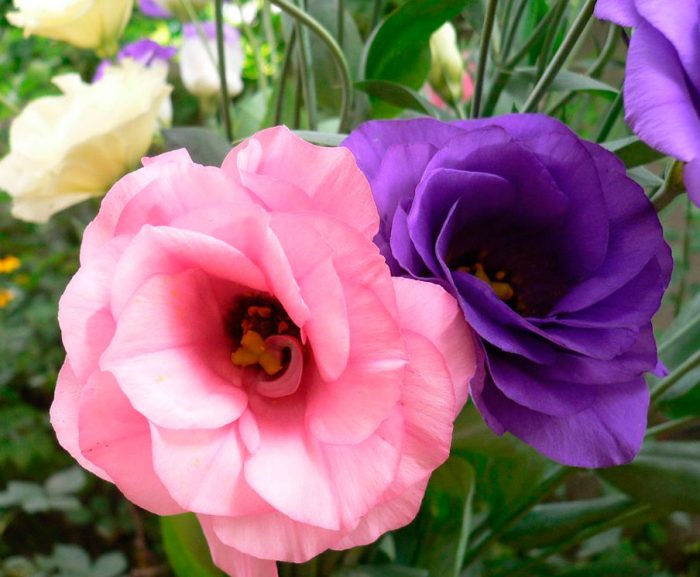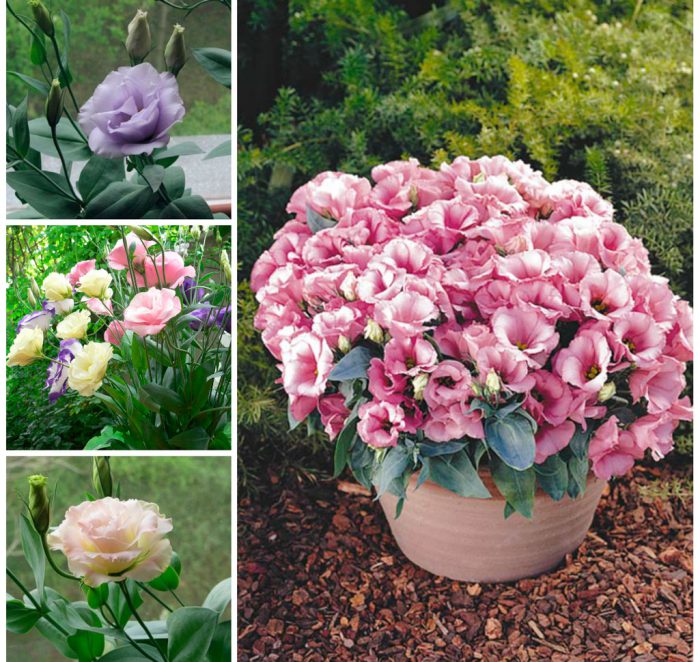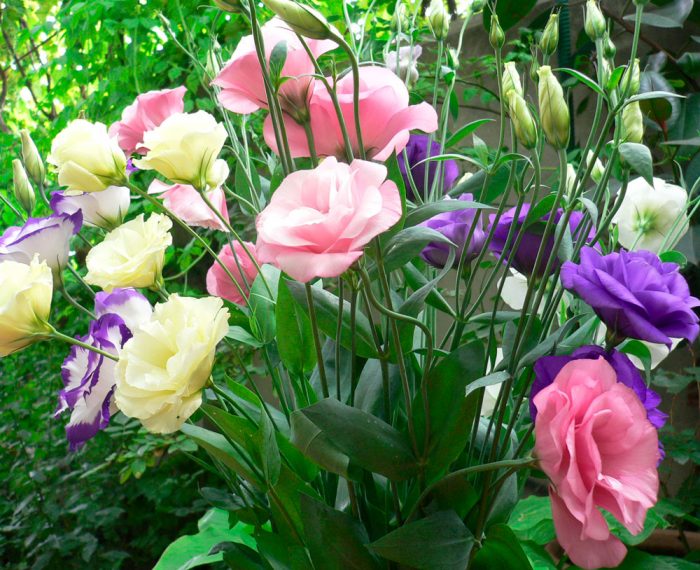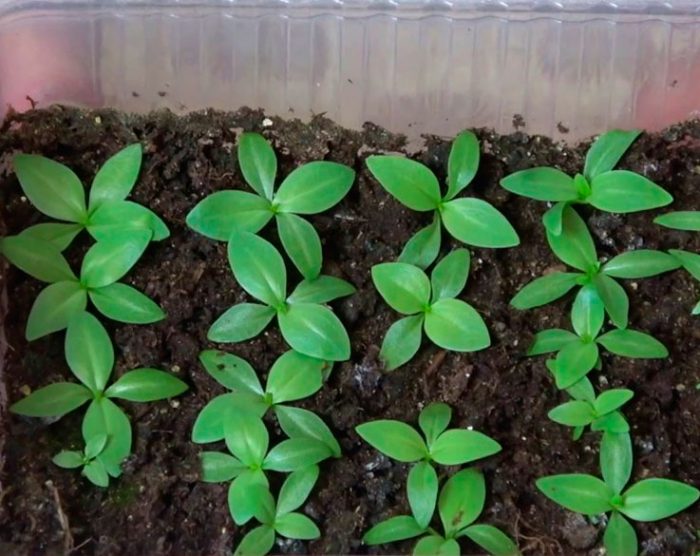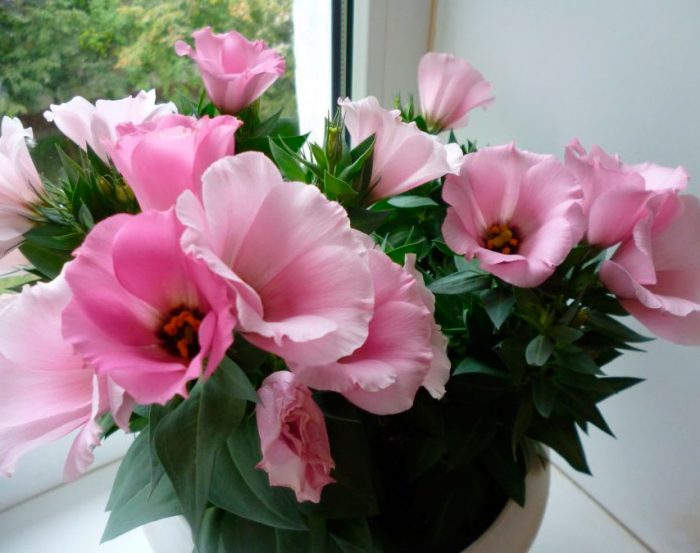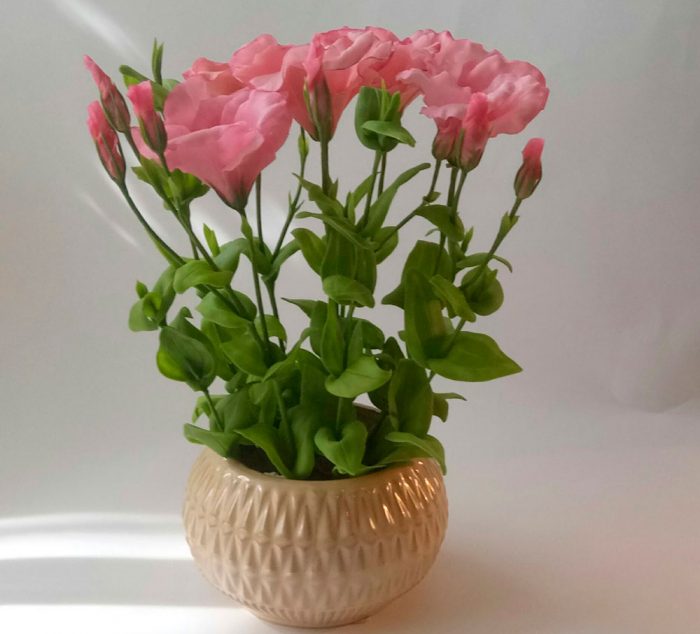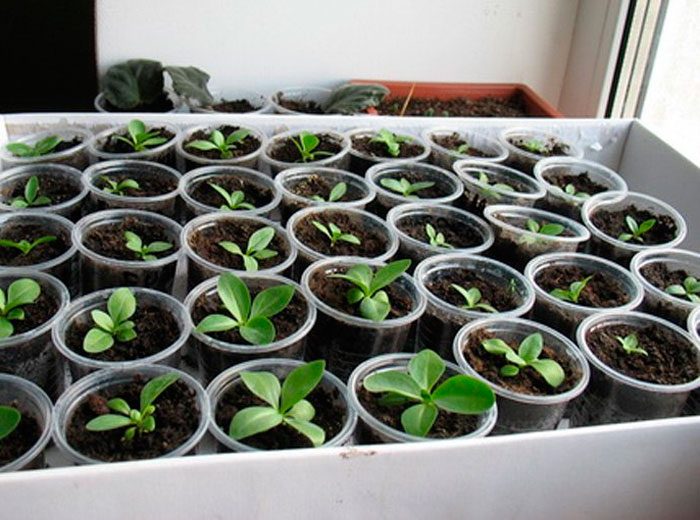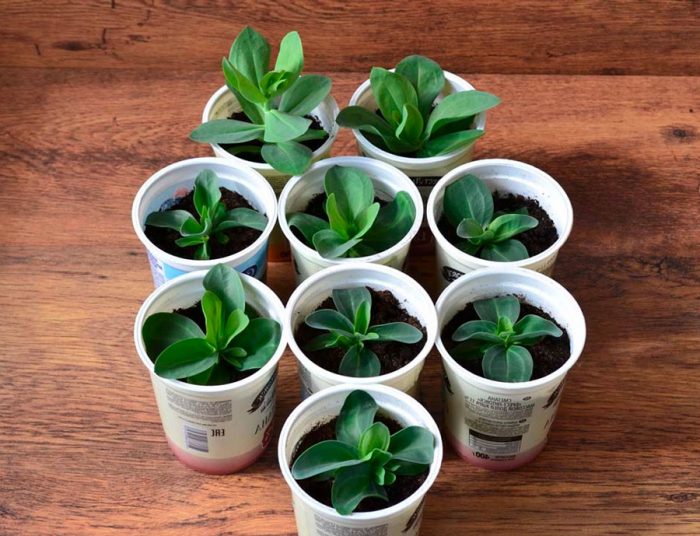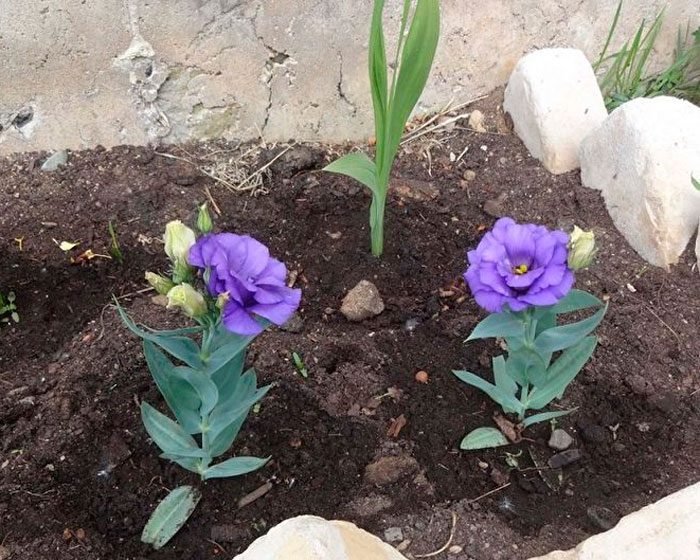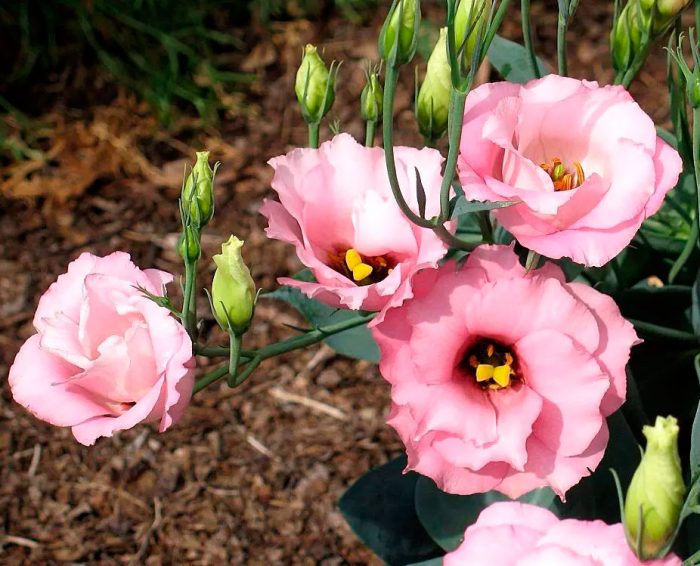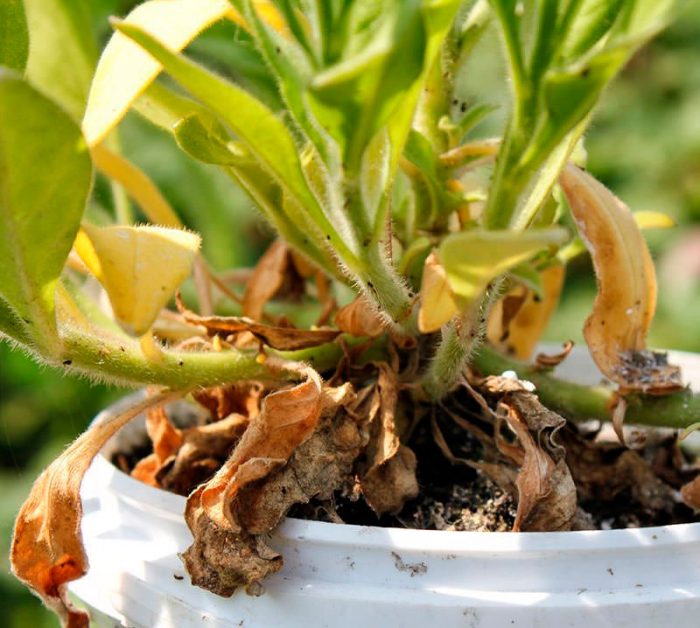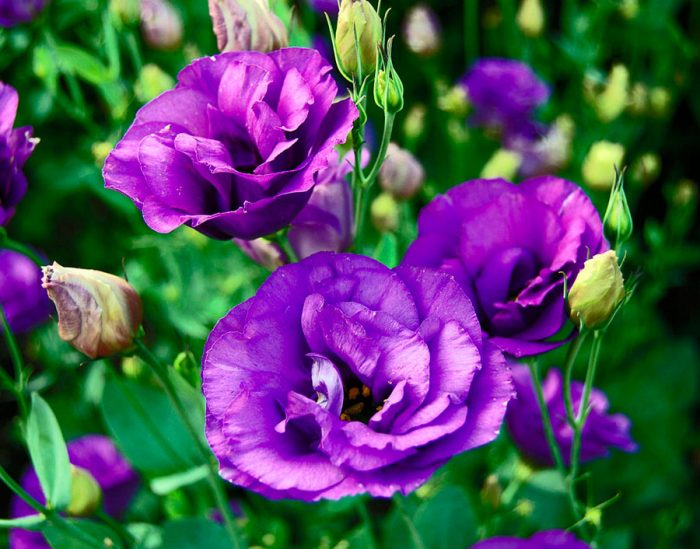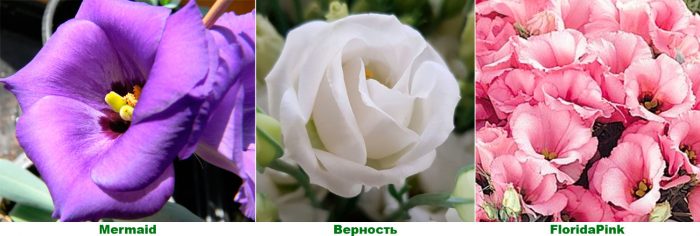The plant eustoma (Eustoma), also called Lisianthus ("bitter flower"), or "Texas bell", or "Irish rose", or "Japanese rose", is a representative of the gentian family. The name eustoma literally translates from Latin as "beautiful mouth", but there is another more literary version - "beautifully speaking". This plant comes from Mexico, from the islands of the Caribbean, and also from the northern part of South America and from the south of North America.
The American Indians have a legend that tells that for the first time Lisianthus bloomed on the grave where an innocent girl was buried, who was killed by the spirit of war because she did not want to marry him. Lisianthus ended up in Europe thanks to Patrick Brown, who was an Irish botanist and physician. Eustoma is very popular among flower growers and is grown for cutting. The fact is that freshly cut flowers of such a plant in water can stand for a very long time (up to 20 days). As an indoor flower, eustoma began to be cultivated only in the nineties of the twentieth century.
Content
Brief description of cultivation
- Landing... Sowing seeds for seedlings is carried out in the last days of February or the first of March. Seedlings are transplanted into open ground 3 months after the seedlings appear.
- Bloom... From mid to late summer.
- Illumination... Penumbra or shadow.
- Priming... Loose, dry, light and permeable to water and air. Also, the soil should be neutral.
- Watering... The soil should be moistened systematically, but sparsely. Drip irrigation is best suited for eustoma.
- Fertilizer... Complex mineral fertilizer is applied to the soil regularly once every 2 weeks.
- Reproduction... Growing from seeds.
- Pests... Thrips, whiteflies, spider mites and slugs.
- Diseases... False gray rot, fusarium, late blight, powdery mildew, root rot, and tobacco mosaic virus.
Features of eustoma
Powerful stems of eustoma reach a height of about 100 cm, but they look very elegant. The branching of the stem begins from the middle, in this regard, having cut off one branch, you will have a real bouquet in your hands, numbering up to 35 buds, the opening of which occurs one by one.Matte gray or pale gray leaf plates, as if made of wax, have a lanceolate-oval shape. The flower has a deep and large calyx, funnel-shaped. Non-double or double flowers reach from 50 to 80 mm in diameter, they are painted in lilac, purple, pink or white. In this case, the flowers can be monochromatic or have a contrasting border. The half-open bud of Lisianthus is outwardly similar to a rose, and after it has fully blossomed, it resembles a terry poppy.
Under natural conditions, eustoma is a biennial, but in horticulture it is usually cultivated as an annual. As a perennial, such a flower is grown only in indoor conditions. In the garden, it can be cultivated as an annual or biennial.
Basic rules for the cultivation of Lisianthus:
- The plant needs to provide diffused but bright light.
- It grows best in humus from peat and bark (1: 1).
- For reproduction, only the seed method is used, because the root system of the bush is very fragile and will not tolerate division, and the cuttings do not have roots.
- Watering is carried out only when the soil mixture dries out to a depth of 20 mm.
- It is impossible to transplant lisianthus when grown indoors. The fact is that in this case it is considered a perennial only conditionally, since its delicate roots cannot tolerate a transplant.
- The most lush flowering of indoor lisianthus is observed in a cool and well-ventilated area.
Growing eustoma from seeds
Growing lisianthus indoors takes a lot of time and patience. But if you master this process, you can turn the cultivation of eustoma from seeds into a profitable business, since every year it is gaining more and more popularity among both flower growers and gardeners.
Difficulties can begin already during sowing, since the seeds of this plant are very small (there are up to 23 thousand of them in 1 g). The seeds sold in specialized stores undergo special processing, which increases their germination. In this regard, out of 100 such seeds, seedlings give about 60. If the seedlings are grown for planting in open ground, then the seeds are sown in February-March, then in this case the bushes will bloom in July-August. The soil mixture for sowing is used the same as for other flowering plants, namely: disinfected, with a pH of 6–7 and a low nitrogen content. Fill the container with a damp substrate and distribute the seeds evenly on its surface, you do not need to sprinkle them with a layer of earth, but just press lightly with your hand. Cover the container on top with glass (film), while there should be cracks left so that air can circulate. Also, crops will need additional lighting with fluorescent lamps for 10-12 hours a day. In order for the seeds to germinate, they are provided with a temperature not lower than 14 degrees at night and not lower than 20 degrees during the day. Water the crops from a spray bottle, but only if necessary. The first time watering can not be carried out, because the evaporated moisture will be enough for the seeds.
If you do everything correctly, then the first seedlings will appear in about 15 days, immediately after that the glass is removed completely, and the seedlings are systematically moistened from the sprayer with Fitosporin solution. After the seedlings have formed several pairs of leaf plates (after about 6 weeks), they are picked into separate pots, reaching from 40 to 50 mm in diameter. After 3 months, the bushes are transplanted into the garden, and they are taken along with a lump of earth.
Eustoma at home
Landing
If you want Lisianthus to delight you with its winter bloom, then the seeds should be sown between July and September. Take a not very large container and fill it with moistened soil mixture, which includes peat and sand. Spread the seeds evenly over the surface.The container is covered with glass or film on top and removed to a warm (from 19 to 22 degrees) and well-lit place. If necessary, moisten the crops with a spray bottle, and after 15–20 days the first seedlings will appear.
Seedling care
After the first pair of true leaf plates is formed at the seedlings, the frequency of watering is reduced and they are carried out only when the surface of the substrate dries well. The grown seedlings are watered only in the morning, because moisture remaining on the foliage overnight can cause the development of the "black leg" disease. After the seedlings have formed 2 pairs of true leaf plates, they are picked into individual pots. Bushes will bloom in January or February.
Illumination and temperature
Growing lisianthus indoors is quite difficult, as it needs fresh air and diffused bright light. Best of all, the flower will grow on an eastern or western windowsill, and a room should be chosen that can be systematically ventilated in order to maintain an air temperature of 19 to 22 degrees, which is optimal for eustoma.
Watering
Water the flower sparingly, using soft and well-settled water. Moisten the soil mixture in the pot only after its top layer dries out. Make sure that the earthen lump in the container does not dry out, but moisture stagnation in the root system should also not be allowed. It is impossible to moisten the foliage from the spray bottle, as this can cause various diseases to strike it.
Top dressing
During the formation of buds and during the growing season, the bush is fertilized with a solution of liquid complex fertilizer (for 1 bucket of water from 10 to 15 ml).
Bloom
Also, do not forget to promptly cut off the flowers that have begun to fade. If everything is done correctly, then after 90-100 days the bush will bloom again.
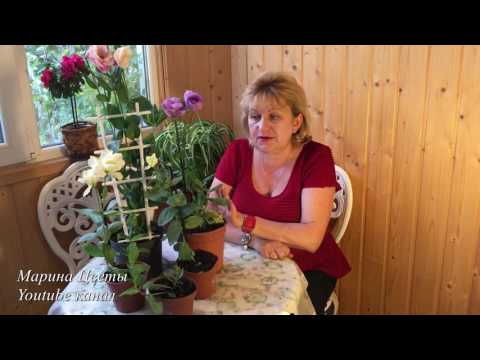

Watch this video on YouTube
Planting and care in the open field
Sowing
If you decide to grow lisianthus in your garden, then sow the seeds in December – January. In this case, the bushes will bloom in June – July. To do this, take 50 ml cups and fill them with violet substrate. From 3 to 5 seeds are spread on its surface, and they are not sprinkled, but only slightly pressed into the soil mixture. Be sure to cover the cups with foil (glass) on top to create greenhouse conditions for crops. Raise the shelter regularly once every 1.5 weeks to remove condensation from it and ventilate the crops. Seedlings appear best at temperatures between 20 and 25 degrees, and they should appear after half a month.
For the first 2 months, the bushes will need additional lighting. However, even with sufficient light, seedlings still grow extremely slowly. In the last days of February, the seedlings are transferred to a well-lit windowsill.
Seedling care
Preventive treatment of seedlings from diseases is carried out with a solution of Fundazol (1 tsp for 1 liter of water). And to accelerate growth, the bushes are treated with a solution of Epin or Zircon. 4–6 weeks after the appearance of the seedlings, when a pair of true leaf plates develop on them, they should be cut into separate pots of 3-5 pieces, while the plant is planted in the substrate along the lower leaves. Next, the bushes are watered and a plastic bag is put on top of the pots to create greenhouse conditions. After 7 days, the plants should grow a couple of times. In the last days of February or the first days of March, plant the seedlings in larger pots, reaching 80 mm in diameter, by transferring them together with a lump of earth. Do not forget to make a drainage layer at the bottom of each pot. Further, the seedlings will actively grow and develop.
Planting seedlings
It is necessary to plant the grown seedlings in open ground in mid-May, at which time return spring frosts should be left behind.A suitable place for planting is chosen well-lit (the light should be diffused), which has reliable protection from drafts. Well-drained soil is needed. Seedlings are planted on a cloudy day or in the evening.
Planting pits are made in the prepared soil, which must be spilled with water. When the liquid is absorbed, a seedling is planted into it by transshipment, and try not to collapse the earthen lump. Lisianthus grows in open ground as a bush, in this regard, when planting, the distance between plants should be from 10 to 15 centimeters. For the first 15–20 days, the bushes should be covered with cut plastic bottles or glass jars, and there is no need to water them at this time. How to water a plant is described in detail at the beginning of the article, do not forget only that eustoma can be harmful, both a lack of moisture and stagnant water in the roots.


Watch this video on YouTube
Flowering features
After 6–8 leaf plates have formed on the shoot, pinch its upper part, in this case the bushes will be more lush. After about 30 days after planting, when the flowers have completely taken root, they are fed with a solution of mineral fertilizer. In this case, you can use Plantafol.
In June, flowers are treated with a solution of Plantafol growth, which contains a lot of nitrogen, and in July-August with Plantafol, budding. Also, a solution of Kemir's remedy is suitable for feeding, it is poured directly under the root of the eustoma. Just remember that the concentration of nutrient solutions should be slightly less than the manufacturer recommends (see the package).
The flowering time of Lisianthus is related to when exactly you sowed the seeds. If the seeds were sown in the last days of November or the first ones in December, then the bushes will bloom in the first half of July (it also depends on the weather in spring). Bushes grown from seeds sown in mid-January usually begin to bloom in August. Flowering lasts continuously until October, after some flowers wither, others open. Lisianthus is not afraid of early frosts, only when the temperature drops to minus 10 degrees and snow falls, flowering stops. In the event that the flowering is over too early, it is recommended to cut off all the wilted flowers, and maybe after about a month and a half the bushes will bloom again magnificently.
Diseases and pests
Slugs, spider mites, aphids and whiteflies can settle on such a plant. To save flowers from such pests, the following means are used: Fitoverm, Confidor, Aktara or Aktellik.
Flowers can get sick with fusarium, powdery mildew or gray mold, to help them, they resort to preventive treatments with Fundazole solution, you can also use Ridomil Gold.
Post-flowering care
After the indoor lisianthus has faded, its stems are shortened to two or three internodes, and the bush itself is stored in a room with a temperature of 10 to 15 degrees. Watering the plant during the dormant period is scarce and infrequent, fertilizers are not applied to the soil mixture. When young shoots appear in spring, they replace the substrate with a new one. Resume regular watering and start tending the flower as usual.
In order for the garden lisianthus to bloom longer, it is dug up and, together with the garden soil, is planted in a pot, which is placed on a balcony or windowsill. Take care of the bush as usual and it will bloom for a while. However, someday it will still fade. Remove all wilted flowers, and when the foliage of the plant turns yellow, do the same with garden lisianthus as with indoor lisianthus, namely: shorten its stems to 2-3 internodes and remove the bush in a well-ventilated cool room, watering is greatly reduced. There he will stand until spring.
Types and varieties of eustoma with photos and names
Despite the fact that there are about 60 species of lisianthus in nature, only Russell's eustoma (Eustoma Russelianus) is grown indoors, and only large-flowered eustoma (Eustoma Grandiflorum) is cultivated in the open field. Some growers believe that these plants belong to the same species.
All types and varieties of lisianthus can be divided according to their intended purpose. There are both undersized lisianthus (height no more than 0.45 m), and vigorous. At the same time, tall varieties are most often cultivated in open ground and used for cutting, and undersized varieties are most often grown as balcony or indoor plants.
Tall garden eustoma for cutting
- Aurora... The bush reaches a height of 0.9-1.2 m, double flowers are painted in white, pink, blue or light blue. This plant blooms 15–20 days earlier than other varieties.
- Echo... The height of the spreading stems is up to 0.7 m, large flowers can be painted in different colors (11 color variations), and there are both bicolor and monochromatic. Early flowering.
- Heidi... The bush has a height of about 0.9 m, it blooms magnificently with simple flowers. There are 15 color variations of flower color.
- Flamenco... Plant height varies from 0.9 to 1.2 m, powerful stems are decorated with simple, but very large (diameter about 80 mm) flowers, which can be colored in various shades. This variety is good because it is not capricious.
Low-growing varieties of eustoma for growing in an apartment
- Mermaid... Bushes from 12 to 15 centimeters high adorn simple flowers, reaching about 60 mm in diameter, they are colored blue, purple, white or pink. The plant is branched, so pinching is not needed.
- Littlebell... The height of the bush is about 15 centimeters, small, simple funnel-shaped flowers are painted in different color shades. No pinching is needed.
- Fidelity... Plant height is about 20 centimeters. On the peduncle, many simple, not very large flowers are arranged in a spiral, they are painted white.
- Florida Pink... Pink simple flowers form a lined bouquet on the bush.


Watch this video on YouTube

